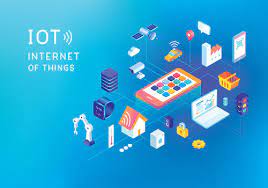The IoT ecosystem consists of interconnected components that work together to enable the functioning of IoT systems. Here are the key components of the IoT ecosystem:
- Devices and Sensors: IoT devices are physical objects or systems that are equipped with sensors, actuators, and connectivity capabilities. These devices can range from simple sensors to complex machines, wearables, vehicles, appliances, and infrastructure components. Sensors collect data from the environment, while actuators enable devices to perform actions based on the received data.
- Connectivity: Connectivity is a crucial aspect of the IoT ecosystem. It enables devices to communicate with each other, with cloud-based platforms, and with other systems. Various connectivity options are used in IoT, including Wi-Fi, Bluetooth, cellular networks (2G, 3G, 4G, and 5G), LPWAN (Low-Power Wide Area Networks) such as LoRaWAN and NB-IoT, and wired connections like Ethernet.
- Networks: IoT devices and systems require networks to transmit data. These networks can be local area networks (LANs) within a confined area, such as a home or a building, or wide area networks (WANs) that cover larger geographical areas. Additionally, IoT systems may utilize specialized network architectures like mesh networks or star topologies, depending on the requirements of the application.
- Cloud Computing and Edge Computing: Cloud computing plays a significant role in the IoT ecosystem. It provides scalable storage, processing power, and data analytics capabilities to handle the massive amounts of data generated by IoT devices. Cloud platforms enable data storage, real-time analysis, and remote management of IoT systems. Edge computing complements cloud computing by performing data processing and analysis closer to the data source, reducing latency and bandwidth requirements.
- IoT Platforms: IoT platforms are software frameworks or middleware that facilitate the development, deployment, and management of IoT applications. These platforms provide tools and services for device management, data ingestion, storage, analytics, and visualization. They also often include APIs, development kits, and security features to simplify the implementation of IoT solutions.
- Data Analytics and Artificial Intelligence: The data generated by IoT devices holds valuable insights. Data analytics techniques, including machine learning and artificial intelligence, are employed to process and analyze this data. These techniques help extract patterns, detect anomalies, make predictions, and enable intelligent decision-making in IoT systems.
- Applications and Services: IoT applications are the end-user interfaces or software solutions that leverage the capabilities of IoT devices and systems. These applications can be mobile apps, web dashboards, or specialized software designed for specific industries or use cases. IoT services can include remote monitoring, predictive maintenance, asset tracking, energy management, and more.
- Security and Privacy: Security is a critical component of the IoT ecosystem. With numerous interconnected devices and data exchanges, ensuring the confidentiality, integrity, and availability of data is essential. IoT security measures include authentication, encryption, access control, and secure communication protocols. Privacy considerations involve handling sensitive data, obtaining user consent, and complying with privacy regulations.
The IoT ecosystem is a complex and interconnected network of devices, networks, platforms, and applications that work together to enable the collection, processing, and utilization of data for various purposes. Collaboration across these components is vital to create robust and efficient IoT systems.
SHARE
